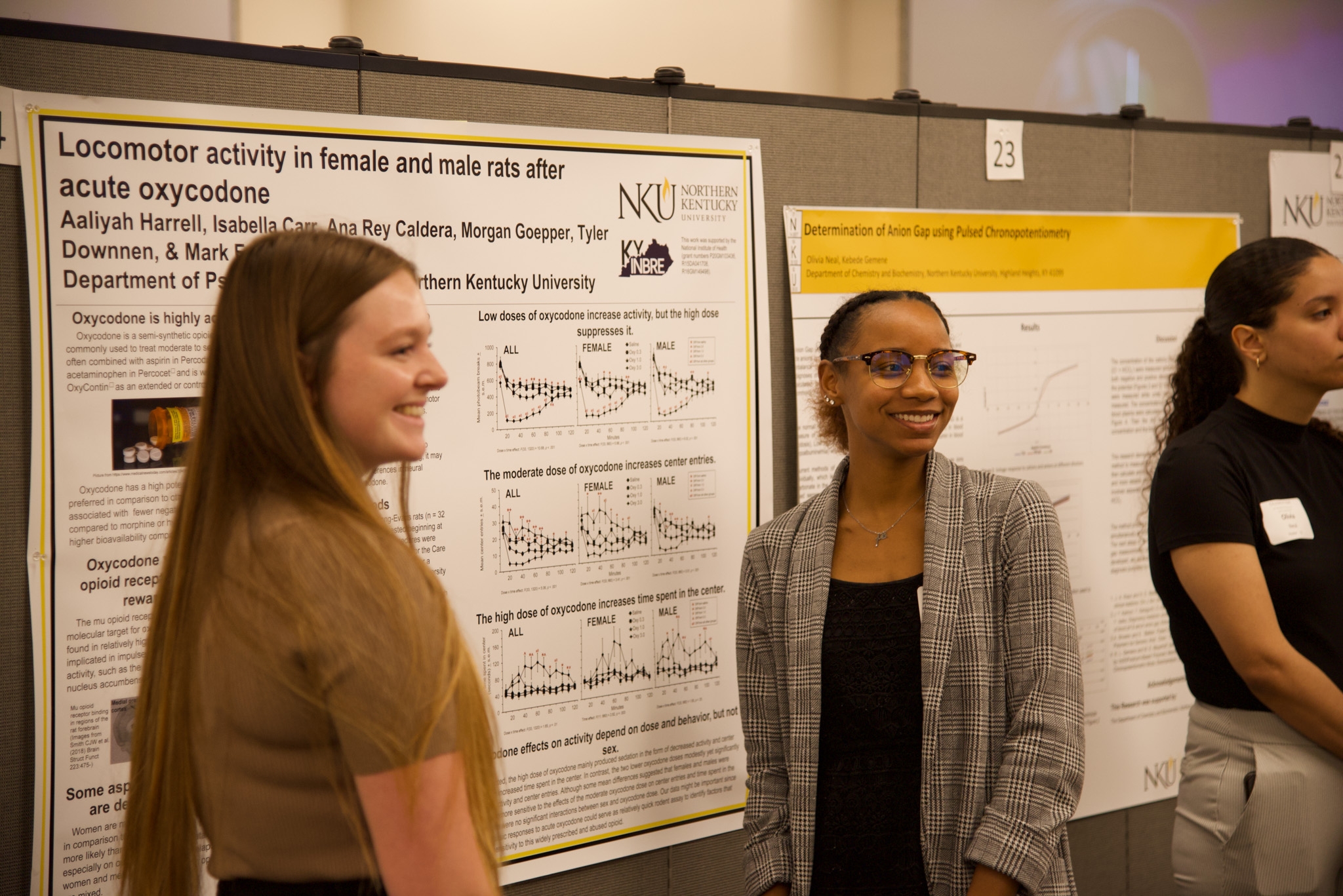
Photo: Sam Wade
Northern Kentucky University (NKU) observed its 22nd annual Celebration of Student Research and Creativity April 17, turning the James C. and Rachel M. Votruba Student Union first floor into a hub for scholarship. While students gave oral slideshow presentations in nearby conference rooms, others filled the H. Gordon and Thelma S. Martin Ballroom with posters displaying the research they’d conducted over the semester, explaining their findings to curious passers-by.
“My favorite part of Celebration is wandering through the ballroom once all the posters go up,” says Shauna Reilly, assistant provost for experiential learning at NKU. “I love when students return that we’ve seen since their first year here. I just watched a student give an oral presentation who did a summer fellowship three years ago, and Posters-at-the-Capitol another year. It was great seeing his progression over time.”
Celebration is a major portion of NKU’s yearly Experiential Learning Week, which showcases opportunities like studying abroad, internships and student research. Meet just a few of the students who presented their work on Wednesday:
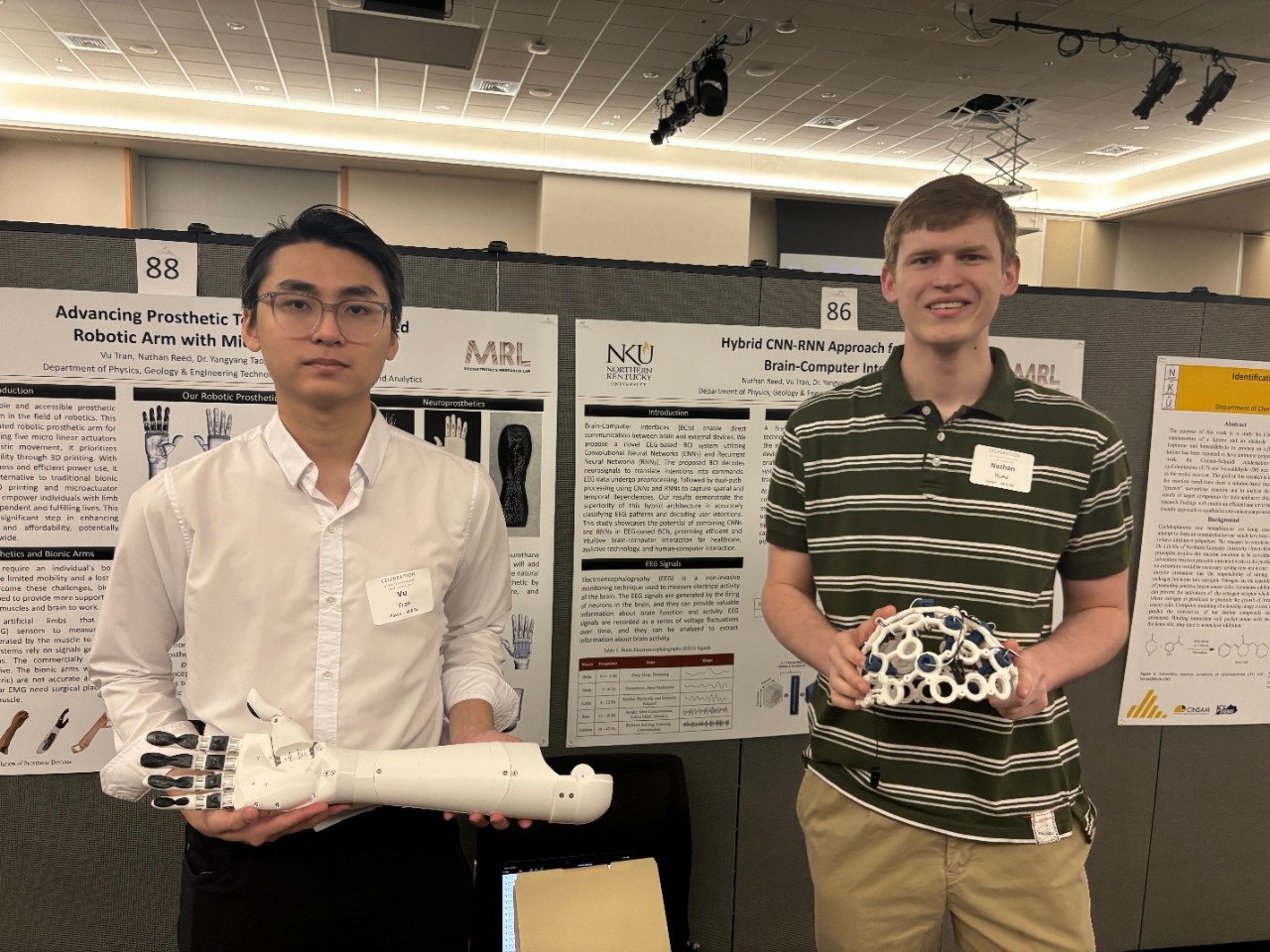
Prosthetics That Empower
Computer science major Nathan Reed and mechatronics engineering technology major Vu Tran submitted separate but overlapping poster presentations to Celebration. Using 3D-printing technology, they created an affordable and accessible prosthetic arm, that can be controlled by a wearable brain-computer interface.
“Traditional bionic arms don’t look very natural,” says Tran. “So, we came up with the idea to use five actuators so that you can control each finger individually.”
The limbs’ fingers are composed of a flexible polyurethane material, which can simulate sensory feedback like touch, pressure and temperature.
“We’ve been working on this project since the start of the semester,” adds Reed. “The software side uses an EEG headset, which records brain waves and then uses a combination of neural network to classify those signals into different operations.”
Tran and Reed hope their project can empower individuals with amputations to live more independently, providing an easier-to-use alternative to other prosthetics.
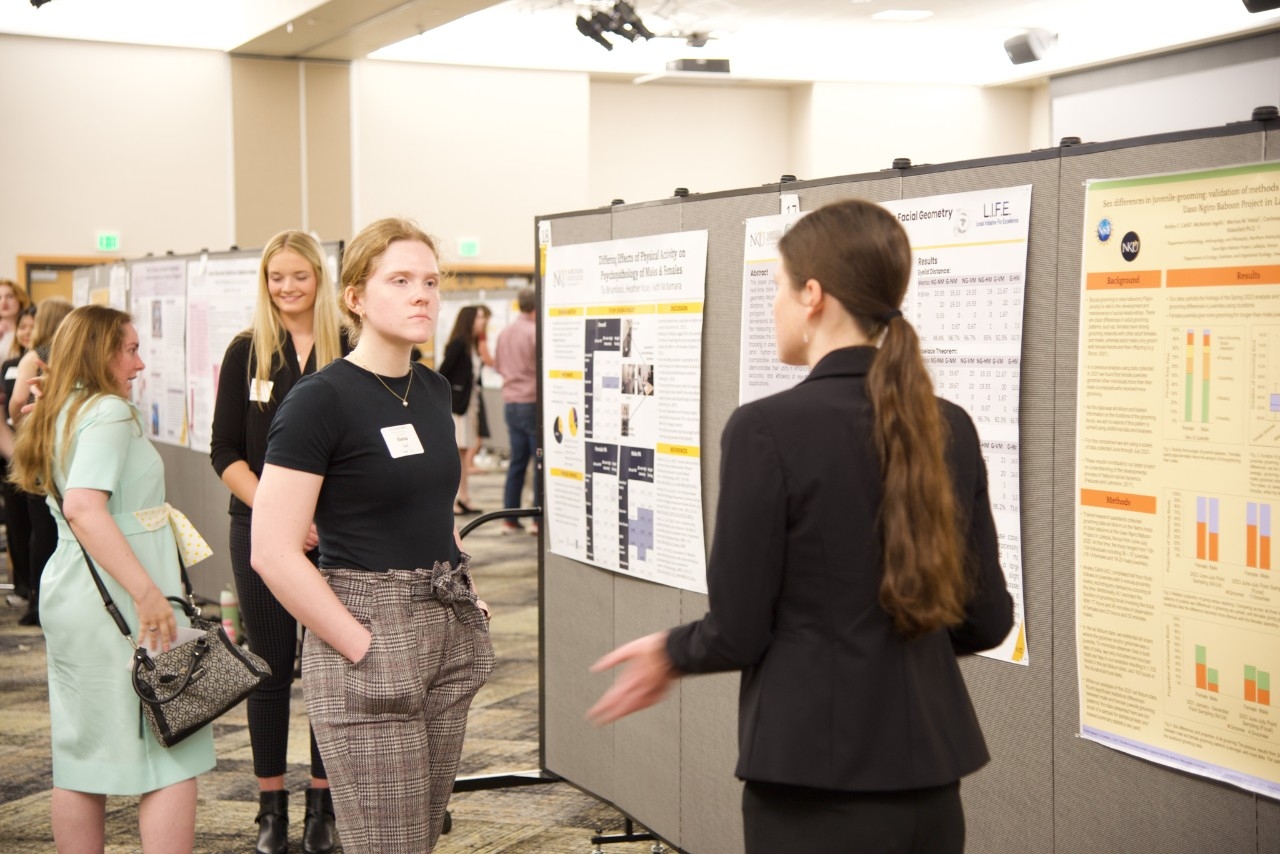
Photo: Sam Wade
In the Blink of an Eye
Elaina Hall, a neuroscience minor, joined fellow computer science major Tyler Egloff in researching eye tracking and blink detection due to their applications in both of her fields of study.
“Blinks are actually a really good indication of underlying cognitive processes, so we were trying to find the most optimized approach for blink detection” Hall says. “We tried a few methods, and we found that the particular algorithm we used had three-dimensional facial landmarks as opposed to the two dimensions that are usually used. When you add that third dimension, it really increases the accuracy of light detection.
Hall says that working with Dr. Nicholas Caporusso as her faculty sponsor has had a major positive impact on her studies.
“There’s a lot going on at the lab at one time, but he makes time for each of us,” she says. “He makes sure we get the instruction and resources we need. He actually helped us get a publication on this research study accepted to a conference.”
The implications of the research are greater than Hall and Egloff originally anticipated: Hall says that they hope their findings can help diagnose conditions like depression through eye-tracking.
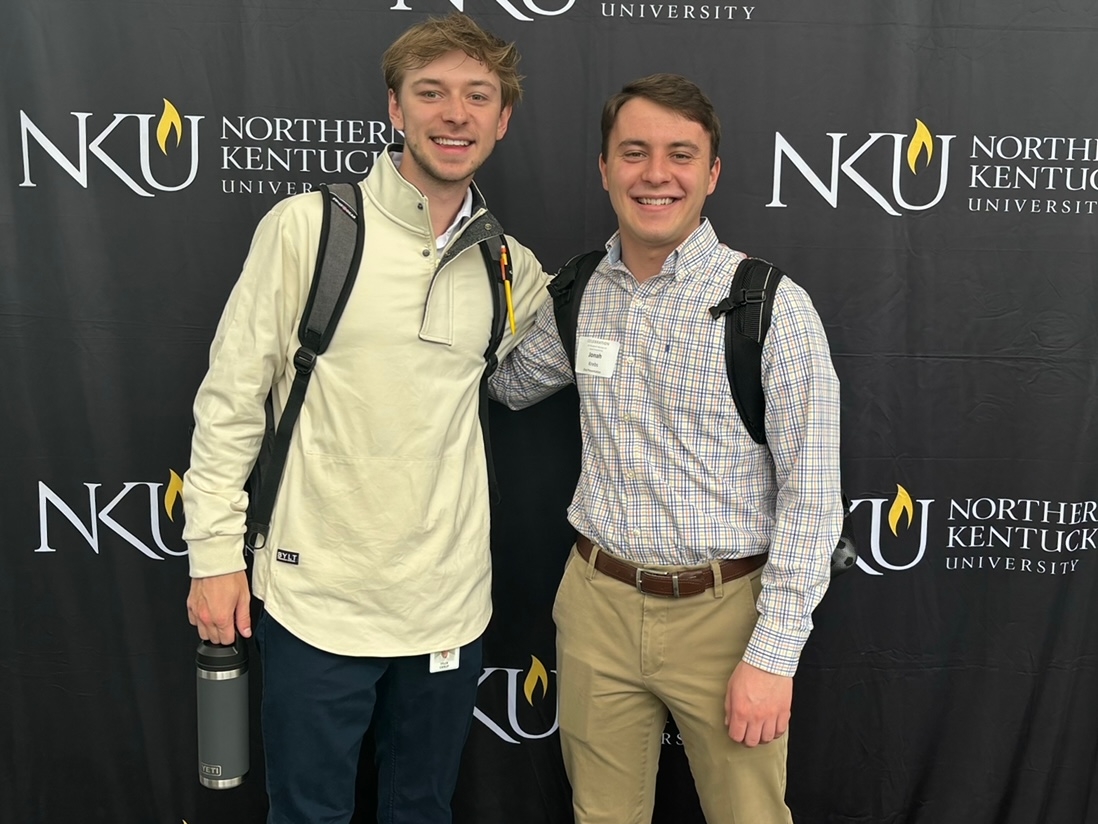
Scrutinizing Sports Fandom
Classmates in their senior seminar for economics, Jonah Krebs and Tyler Canup, gave back-to-back oral presentations that examined the demographics of sports fandom. Krebs’ presentation used data from Dr. Joe Cobbs’ Know Rivalry research project to determine how the intensity and composition of rivalries between teams are differently perceived based on fans’ ages, level of education and geographic locations.
Know Rivalry’s data collects responses from sports fans worldwide by asking participants to allocate “rivalry points” to opposing teams while surveying them about the specific feelings that drive these conflicts.
“I’ve been working with Dr. Cobbs on the Know Rivalry project for a while. This is year four now,” Krebs says. “It’s been a great experience. I actually had the opportunity to nominate him for the ISRCA Student Research/Creativity Mentor Award two years ago.”
Krebs hypothesized that younger fans would express higher levels of animosity toward their top rivals, while older fans would report a higher total number of rivalries. After completing his research, he was surprised by some of his findings. While the oldest survey subjects did tend to consider a larger amount of teams as rivals, remembering, for example, the years in which the Cincinnati Reds and Los Angeles Dodgers competed in the same division, fans ages 18-29 also named a wide range of adversaries.
Canup, whose presentation explored whether the increasing average age of the global population affected fans’ choices to see games on television rather than in person, said that his research was inspired by his lifelong love of sports and the main topic of his seminar: age demographics. Using the American Time Use Survey (ATUS), he found data supporting his hypothesis that older fans were less likely to buy tickets to the ballpark or stadium but felt that the effects of the COVID-19 pandemic may have influenced these findings.
Canup currently works part time at First Financial Bank and will transition to full time after he graduates this year. Krebs plans to make a similar step up to full time work as an employee in FC Cincinnati’s accounting department.
“The accounting world and sports world overlap for me,” Krebs says.
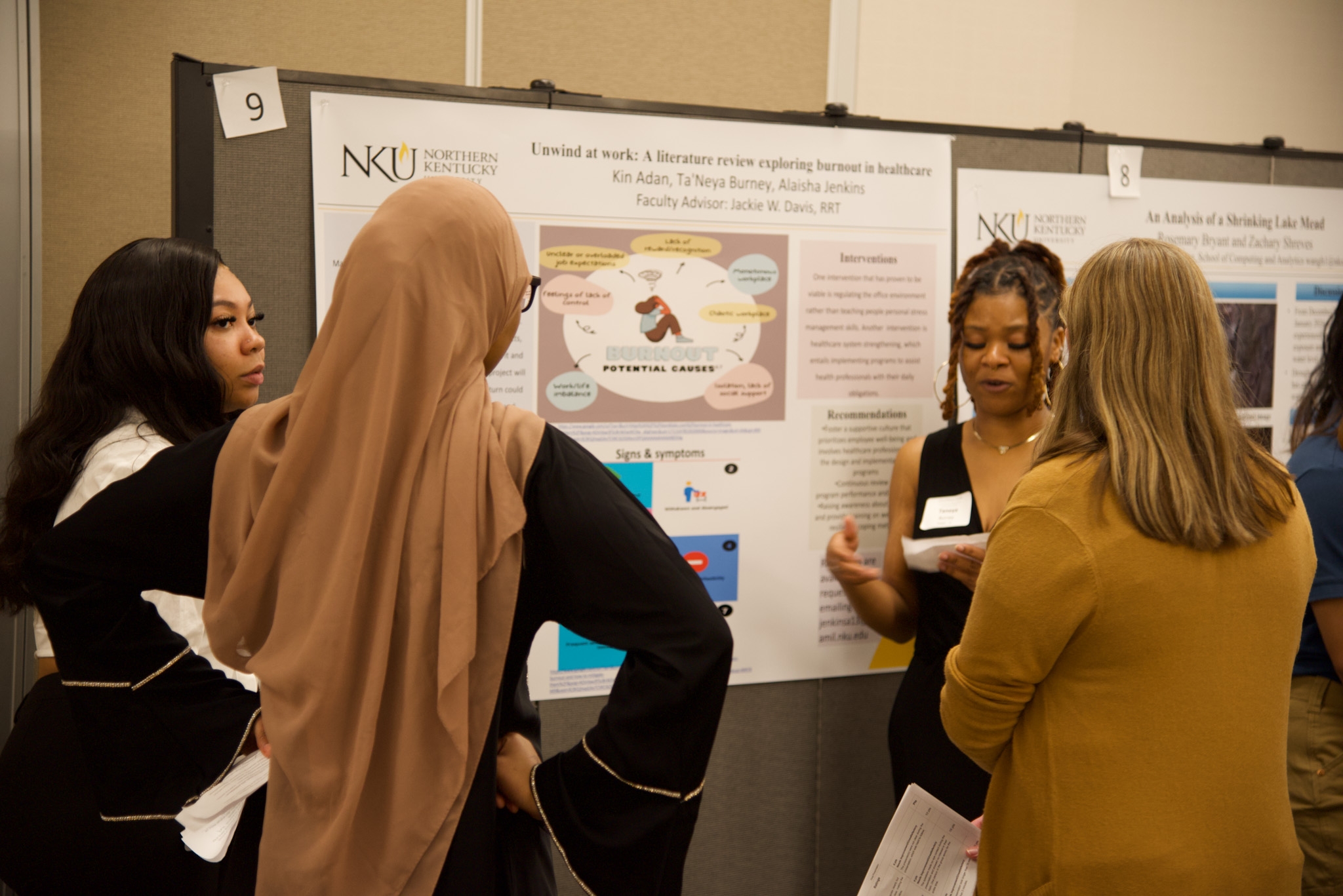 Photo: Sam Wade
Photo: Sam Wade
Navigating Burnout
As students who work in healthcare, Alaisha Jenkins, Kin Adan and Taneya Burney say that they have all been the victim of burnout in their respective careers. Their group poster presentation, “Unwind at Work: A Literature Review Exploring Burnout in Healthcare,” studied how factors like stress, isolation and work/life imbalance can affect the performance and wellness of those in the medical field.
“Burnout has been very prevalent in healthcare, especially since COVID,” says Jenkins. “It can make people withdrawn from their work and cause mistakes.”
“We found that the best intervention is teaching people to manage their stress and fostering supportive culture systems that prioritize employee well-being,” Burney adds.
Jenkins says that over the past few years, it appears that hospitals are paying greater attention to the perils of burnout.
“The hospital I work at has started to implement a meditation program,” she says. “We have a quiet room designated for people who are feeling overwhelmed, and I think that’s a great idea.”
 Photo: Sam Wade
Photo: Sam Wade
Show Me the Money
Inspired by a recent spate of confusing ballot measures in Kentucky, political science majors Heather Rauch and Shae Wright researched the ways that interest groups influence the way voters view environmental issues. Looking back at the past decade in local politics, Wright, who wants to attend law school after completing her undergraduate education, says that she was surprised at the level of technical language that appeared on ballots.
“The readability of these ballot measures can be very difficult—graduate level at times,” she says. “These are supposed to be accessible to the general American public. It also surprised me that there's a positive correlation between money spent in favor of a measure and that measure passing. So really, it all is in the money.”